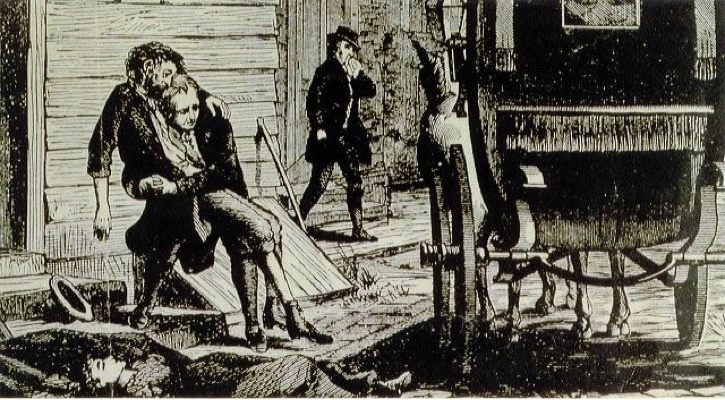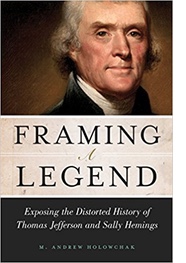What’s Ailing Us? This Is What Jefferson Would Say.

Yellow Fever Epidemic, Philadelphia, 1793 (Source)
Thomas Jefferson, it is well known to historians, had marked anti-city sentiments. “I am not a friend to placing growing men in populous cities,” writes Jefferson to Dr. Caspar Wistar (21 June 1807), “because they acquire there habits & partialities which do not contribute to the happiness of their after life.” Years earlier (23 Sept. 1800), he says to Dr. Benjamin Rush: “I view great cities as pestilential to the morals, the health and the liberties of man. True, they nourish some of the elegant arts, but the useful ones can thrive elsewhere, and less perfection in the others, with more health, virtue & freedom, would be my choice.” To David Williams (14 Nov. 1803), he states that cities encourage too many citizens to try to live by their heads, and not their hands—that is, they discourage husbandry—and that is for Jefferson an impossible state of affairs for human happiness. They also bode ill for any who have a “turn for dissipation.” So great was his enmity of cities that in the 1800 letter to Rush he states that the yellow-fever epidemic that hit Philadelphia and wiped out a large number of its citizens might just be Providence’s way of discouraging “the growth of great cities in our nation.”
 Cities
for Jefferson marked a sort of natural decay—a slip away from the
bucolic, agrarian ideal that Jefferson consistently championed,
though he made certain concessions concerning the need of some
manufacture later in life. In cities that degree of freedom that
gives citizens “a wholesome control over their public affairs” is
absent. What is missing, he tells John Adams (28 Oct 1813), is
ownership and care of land, which conduces to “law and order.”
Owning land, citizens come to know its true value—the yield of
arable land is cornucopian—and will wish to defend it in times of
intra- or international strife. The mobs in cities—and a mob is a
mere instrument of those with rank and birth—wallow in ignorance,
poverty, and vice, and thus are incapable of rational activity. “The
mobs of great cities add just so much to the support of pure
government, as sores do to the strength of the human body,” writes
Jefferson in Query XIX of his Notes on the
State of Virginia in 1787.
To James Madison in the same year (Dec. 20), he writes: “I
think we shall be [virtuous], as long as agriculture is our principal
object, which will be the case, while there remain vacant lands in
any part of America. When we get piled upon one another in large
cities, as in Europe, we shall become corrupt as in Europe, and go to
eating one another as they do there.”
Cities
for Jefferson marked a sort of natural decay—a slip away from the
bucolic, agrarian ideal that Jefferson consistently championed,
though he made certain concessions concerning the need of some
manufacture later in life. In cities that degree of freedom that
gives citizens “a wholesome control over their public affairs” is
absent. What is missing, he tells John Adams (28 Oct 1813), is
ownership and care of land, which conduces to “law and order.”
Owning land, citizens come to know its true value—the yield of
arable land is cornucopian—and will wish to defend it in times of
intra- or international strife. The mobs in cities—and a mob is a
mere instrument of those with rank and birth—wallow in ignorance,
poverty, and vice, and thus are incapable of rational activity. “The
mobs of great cities add just so much to the support of pure
government, as sores do to the strength of the human body,” writes
Jefferson in Query XIX of his Notes on the
State of Virginia in 1787.
To James Madison in the same year (Dec. 20), he writes: “I
think we shall be [virtuous], as long as agriculture is our principal
object, which will be the case, while there remain vacant lands in
any part of America. When we get piled upon one another in large
cities, as in Europe, we shall become corrupt as in Europe, and go to
eating one another as they do there.”
Jefferson’s anti-city arguments are several, but one stands out. Cities offer an unnatural overcrowding of citizens, and where there is overcrowding and land is wanting, the spirit of commerce and attention to making money trumps the desire for liberty and for living off the land. In Query XVII of his Notes on the State of Virginia, Jefferson assumes an atypical somber tone. “From the conclusion of this war we shall be going down hill.” The people and their rights will be forgotten. “They will forget themselves, but in the sole faculty of making money, and will never think of uniting to effect a due respect for their rights.”
Are Jefferson’s views on the evils of urban living applicable today?
To answer that question, ethologist John Calhoun conducted research first on rats and then on mice from 1947 to 1972.What Calhoun did, in effect, was to create in several experiments what was in effect a rodent utopia. The animals were given a large living space and an abundancy of food and water free of predators in a climate-conditioned milieu, which was kept clean to discourage disease. In perhaps the most famous experiment, “Universe 25,” in a paper published in 1973 and titled “Death Squared: The Explosive Growth and Demise of a Mouse Population,” Calhoun constructed a large room, 2.7 meters square, with four separate, but interconnected pens. The mice had 256 apartments for living, each fitting 15 mice, 16 tunnels that led to nourishment, and many access ramps throughout their “universe.”
Beginning with four pairs of mice, Calhoun saw first an adjustment phase of roughly 104 days. After adjustment, there was an “exploit period,” in which the population of mice doubled every 55 days till the population grew to 620. Though the living space could accommodate some 3,000 mice, it soon became cramped, because of overcrowding in certain places of the universe, where food was present, and because of the neglect of other spaces. Yet as eating had become social, the rate of birth soon plunged to some one-third of what it used to be. Of the newly born mice, many were showing signs of social ineptitude.
At around the 315th day, social ineptitude among many male mice became prominent. Without places to emigrate, the socially inept mice no longer protected their spaces or females, were outcast from all groups, and merely tended to wander in the center of the universe to eat, fight among themselves for no obvious reason, and mount other mice, gender being irrelevant. Thus, they exhibited hyper-violence and hyper-sexuality. Female mice, without the protection of males, quickly became aggressive, overly so, in response to lack of male protection, and males’ abandonment of their social functions. They began to cast out their young before fully weaned, to ignore their young, and even to attack or kill their young. Infant mortality rate in pockets of the universe became as high as 90 percent. The population doubling every 55 days slowed to doubling every 145 days.
By the 560th day, there was no discernible population increase and a “death phase” began by the 600th day. Violent, hypersexual displays and lack of social roles brought about a new generation of mice without interest in normal social rodent behaviors—courting, mating, protecting, fighting, and rearing young. Females now showed no interest in reproducing. The indifferent males Calhoun called “beautiful ones,” as they would spend all their time in asocial activities, such as eating, sleeping, and grooming. They were sexually inactive and nonviolent, hence the lack of bodily scars. This phase Calhoun dubbed “first death.” The mice, it seems, were merely biding their time till their actual, “second death”—a bromidic existence.
By day 920, the population peaked at 2,200 mice. With that peak and a population of mostly uncaring, asocial mice, there began a speedy “behavioral sink,” a rapid decline in population that would very quickly lead to extinction.
Calhoun sums: “For an animal so simple as a mouse, the most complex behaviours involve the interrelated set of courtship, maternal care, territorial defence and hierarchical intragroup and intergroup social organization. When behaviours related to these functions fail to mature, there is no development of social organization and no reproduction,” hence quick extinction.
Those results, thought Calhoun, are equally applicable to humans. “If opportunities for role fulfilment fall far short of the demand by those capable of fulfilling roles, and having expectancies to do so, only violence and disruption of social organization can follow. Individuals born under these circumstances will be so out of touch with reality as to be incapable even of alienation. The most complex behaviours will become fragmented. Acquisition, creation and utilization of ideas appropriate for life in a post-industrial cultural-conceptual-technological society will have been blocked. Just as biological generativity in the mouse involves this species’ most complex behaviours, so does ideational generativity for man. Loss of these respective complex behaviours means death of the species.”
Calhoun did not see his studies boding inevitable extinction for humans with increases in population. The rodent behavior was merely a stark warning of a possible, if not probable, future.
Calhoun’s study is more ominous than Malthus’s observations of populational increase and availability of food. Whereas Malthus warned that population growth outstrips the capacity for humans to provide food for themselves, hence a keen competition for available food and a massive dying off of humans, Calhoun’s studies suggest strongly that humans, like rodents, are hard-wired for social activities on account of the need to survive, and in a safe and healthy milieu in which there were no threats to survival, social roles would soon be abandoned, to the detriment of the animals. In sum, social apathy invariably leads to extinction.
Calhoun’s experiments also strongly suggest that social animals are biologically social—that failure to nurture social instincts early in life lead to their extinction. Cramped spaces might be much of the causal picture.
Was Jefferson in his anti-city sentiments so far away from Calhoun? His comments in Query XVII point to indifference of rights in the sole pursuit of making money, once rights are secured. Yet Jefferson was consistently clear that political offices corrupt men and so citizens must always fight for their own rights through recurrent constitutional renewal with each generation, through carefully overseeing elected officials, and through fullest activity in political affairs. Guaranteed the rights to life, liberty, and pursuit of happiness, they also have the right to revolution, when government consistently abuses its power and trumps the rights of citizens. Moreover, Jefferson always at least theoretically championed smaller government to prevent the corrupting effects of urban living, conducive of abusive, centralized government.
Today, it might be said we, without clear socially defined roles or duties, live in a sort of Universe 25, perhaps just prior to Calhoun’s behavioral-sink phase. We are taught to pursue what we want to pursue, without any strong senses of social responsibilities and of other-concern. The elderly, many of whom are cast off in assisted-living facilities, are frustrated and neglected. The working class, though politically polarized on issues of national significance, is much indifferent to local politics—there is no time for it—and busying itself in Jefferson’s prophetic words “in the sole faculty of making money.” The youths of adult age, characterized by bromidic indifference, a sort of learned helplessness, might reasonably be fitted into what is the beginning of Calhoun’s death phase. Are we too leaning toward extinction?
Perhaps Thomas Jefferson with his anti-city views was not such a false prophet.